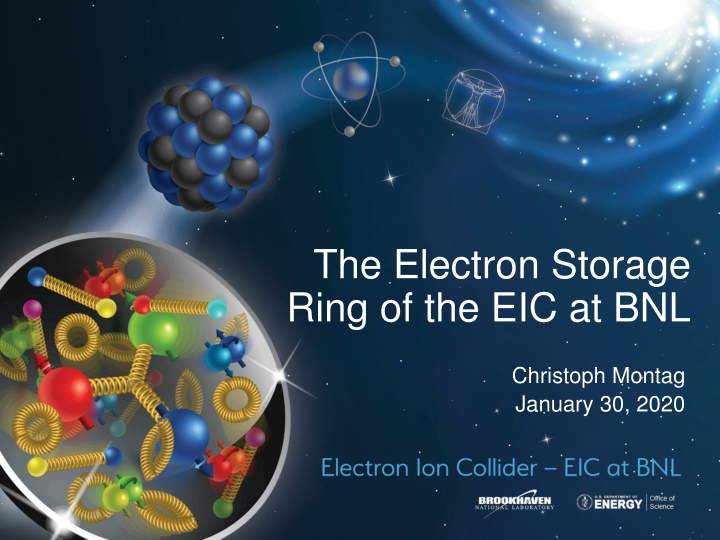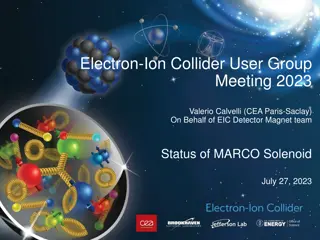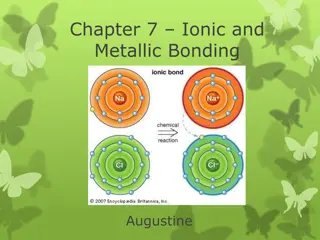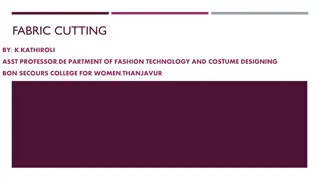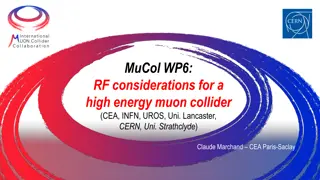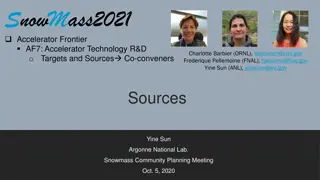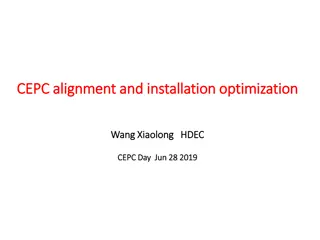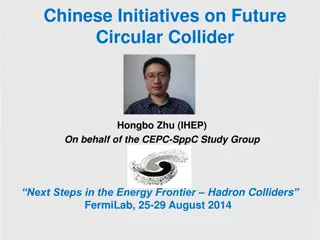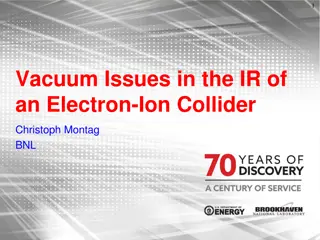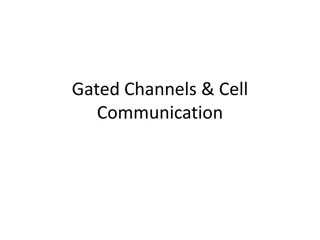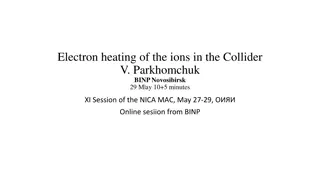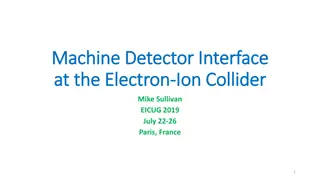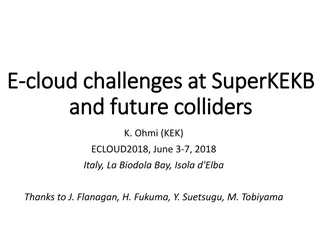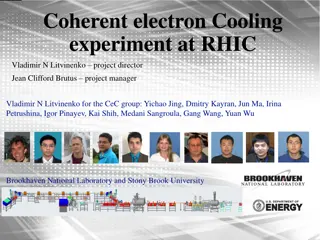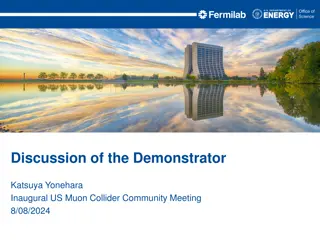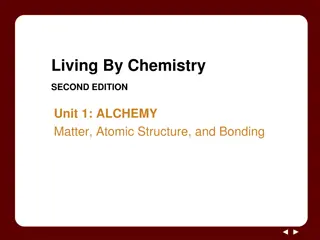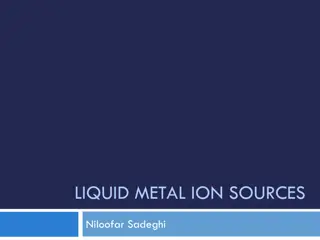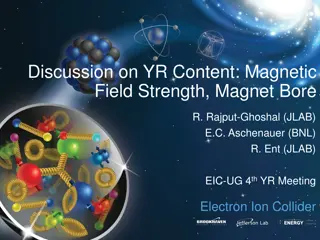Cutting-Edge Electron-Ion Collider Initiatives
The visuals and insights depict revolutionary advancements in the fields of particle physics and nuclear science carried out by the BNL EIC team at Brookhaven National Laboratory, emphasizing the design concepts, requirements, and operational details of the Electron Storage Ring. Discover how the EIC project is pushing boundaries in collider capabilities and enabling in-depth studies of proton structure, atomic nuclei, and spin patterns.
Download Presentation

Please find below an Image/Link to download the presentation.
The content on the website is provided AS IS for your information and personal use only. It may not be sold, licensed, or shared on other websites without obtaining consent from the author.If you encounter any issues during the download, it is possible that the publisher has removed the file from their server.
You are allowed to download the files provided on this website for personal or commercial use, subject to the condition that they are used lawfully. All files are the property of their respective owners.
The content on the website is provided AS IS for your information and personal use only. It may not be sold, licensed, or shared on other websites without obtaining consent from the author.
E N D
Presentation Transcript
The Electron Storage Ring of the EIC at BNL Christoph Montag January 30, 2020
BNL EIC Team G. Bassi, J. Beebe-Wang, J. S. Berg, M. Blaskiewicz, A. Blednykh, J.M. Brennan, S. Brooks, K. A. Brown, Y. Cai, K. A. Drees, A. Fedotov, W. Fischer, D. Gassner, E. Gianfelice-Wendt, W. Guo, Y. Hao, A. Hershcovitch, C. Hetzel, D. Holmes, H. Huang, W. A. Jackson, J. Kewisch, Y. Li, C. Liu, H. Lovelace III, Y. Luo, F. Meot, M. Minty, C. M., Y. Nosochkov, R. B. Palmer, B. Parker, S. Peggs, V. Ptitsyn, V. H. Ranjbar, G. Robert-Demolaize, S. Seletskiy, V. Smaluk, K. S. Smith, S. Tepikian, P. Thieberger, D. Trbojevic, N. Tsoupas, S. Verdu- Andres, W.-T. Weng, F. J. Willeke, H. Wittte, Q. Wu, W. Xu, A. Zaltsman, W. Zhang 2
Modern view of the nucleus The Proton in 2015 Proton in a nucleus The Proton in 1975 The goal of the EIC is to provide us with an understanding of the internal structure of the proton and more complex atomic nuclei that is comparable to our knowledge of the electronic structure of atoms themselves, which lies at the heart of modern technologies. 3
Requirements for the EIC Requirements for an Electron-Ion Collider are defined in the White Paper: High luminosity: L = 1033 to 1034 cm-2sec-1 - factor 100 to 1000 beyond HERA Large range of center-of-mass energies Ecm= 20 to 140 GeV Polarized beams with flexible spin patterns Favorable condition for detector acceptance such as pT =200 MeV Large range of hadron species: protons .Uranium Collisions of electrons with polarized protons and light ions ( 3He, d, ) US DOE granted CD-0 ( Mission Need ) on December 19 4
RHIC Two superconducting 4T storage rings 3.8km circumference Energy up to 255GeV protons, or 100GeV/n gold 110 bunches/beam Ion species from protons to uranium 60% proton polarization world s only polarized proton collider Exceeded design luminosity by factor 44 - unprecedented 6 interaction regions, 2 detectors In operation since 2001 5
BNL EIC Design Concept Take one RHIC ring ( Yellow ) with its entire injector complex as the eRHIC hadron ring Add electron cooling to lower emittance and counteract IBS Modify the hadron ring to be suitable for eRHIC beam parameters Add an electron storage ring in the existing tunnel Use a spin-transparent rapid-cycling synchrotron as full-energy polarized electron injector for rapid bunch replacement to counteract depolarization Build a high luminosity interaction region that fulfills acceptance requirements Brookhaven National Laboratory selected as EIC site by US DOE on January 9 6
Facility layout Electron complex to be installed in existing RHIC tunnel cost effective 7
Parameters for Highest Luminosity Hadron beam parameters similar to present RHIC, but smaller vertical emittance and many more bunches 2 hour IBS growth time requires strong hadron cooling Electron beam parameters resemble a B-Factory 8
Electron Ring Lattice Choice FODO cell provides highest dipole packing factor and is most cost effective Arc cell length ~16m EIC design requires the same horizontal electron ring emittance at all energies (5, 10, and 18 GeV) Required emittances achieved by proper phase advance (90 degrees at 18 GeV, 60 degrees at 10 and 5 GeV), plus radial shift and/or super- bends 9
Synchrotron Radiation Conflicting Requirements: - At high energy, radiation power needs to be minimized by a large dipole packing factor to allow high beam currents - At low energy, synchrotron radiation power needs to be intentionally increased to optimize radiation damping, thus allowing large beam-beam parameters =0.1 Solution: Super-bends 10
Super-Bends Arc dipoles to be split into 3 segments: Vacuum chamber aperture Above 10 GeV, all segments powered uniformly to reduce SR power At 5 GeV, short center dipole provides a reverse bend to increase damping decrement 11
Dynamic Aperture Minimum dynamic aperture requirement: 10 in all three planes, including realistic errors Dynamic aperture studies have focused on 10 GeV, 60 degree lattice (highest luminosity point) 18 GeV, 90 degree lattice expected to be more challenging. 60 degree lattice as backup solution, at lower luminosity For future operation with two detectors, set phase advance between two IRs to 90 degrees to cancel off-momentum -beat (worked for HERA; to be tested in simulations) 12
Electron Ring Dynamic Aperture 12 sigma momentum aperture, without errors 13
On-Momentum Dynamic Aperture with Misalignments 200um RMS misalignment, 500urad RMS roll angle No effect on on-momentum dynamic aperture 14
Dynamic Aperture with Multipole Errors On-momentum DA with re-optimized multipoles in FFQ and PEP-II multipoles in all other magnets Minimum DA > 10 Next step is to add misalignment and magnet strength errors, as well as check momentum DA 15
Polarization in the electron storage ring Experiments require both spin up and down in the same store need a full energy polarized injector (Rapid Cycling Synchrotron, RCS) High initial polarization of 85% will decay towards equilibrium polarization P due to Sokolov-Ternov effect P of 40-50% achievable (HERA experience and BNL-EIC simulations) Time evolution of high polarization of bunches injected into the eSR at 18 GeV (worst case) RCS cycling rate = 2Hz on average, every bunch refilled in 2.2 min B P B P Refilled every 3.2 minutes Refilled every 1.2 minutes Re-injection Pav=80% P = 30% (conservative) Pav=80% Re-injections Note: Calculation with P =30% is conservative as P = 50% was shown feasible 16
Spin Rotators Experiments require longitudinal polarization, while spin in arcs is vertical Solenoid based spin rotators, based on 105 Tm, 7 T solenoids followed by 92 mrad dipoles Spin rotator modules are long blocks of fixed geometry challenging to fit into existing tunnel 17
Vacuum System 3.8km vacuum chamber from CuCrZr alloy Good thermal properties Weldable Easily available Reasonable price Thermal SR power load Maximum temperature 173 C at 10 MW total power, well below yield strength limit Pumping based on integrated NEG Pumps Silver plated sleeve Copper fingers RF Bellows: Critical element of the vacuum system Improved NSLS-II bellows with outside CuCr fingers Contact spring RF spring groove 18
Superconducting RF Single 2-cell 591 MHz SRF cavity per cryomodule V= 8 MV/cavity 2x 500 kW adjustable fundamental power coupler. 4x SiC Beamline HOM Absorbers (BLAs) 14 cryomodules in total Power source: Multiple IOT transmitters configured in groups to achieve required FPC power 2K operating temperature 3rd harmonic RF system under consideration for bunch lengthening, but transient beam loading challenging 591 MHz Cavity Cryomodule 19
Interaction Region +/- 4.5 m machine-element free space for central detector 25 mrad total crossing angle Transverse momentum acceptance down to 200 MeV/c Peak magnetic fields below 6T (NbTi sufficient) Most magnets direct-wind; few collared magnets Challenging synchrotron radiation issues from 2.5A beam 20
Summary EIC electron beam parameters are similar to a B- Factory Need different phase advances and super-bends to achieve high luminosity over large energy range Dynamic aperture requirements at 10 GeV/60 degrees (highest luminosity point) are met. Studies at 18 GeV just started High polarization in two spin states achieved by continuous bunch replacement Spin rotators make geometric layout in existing tunnel next to hadron rings very challenging 21
